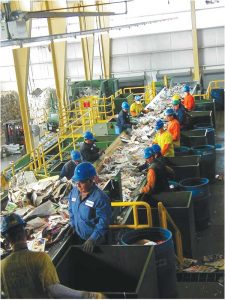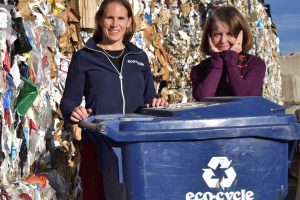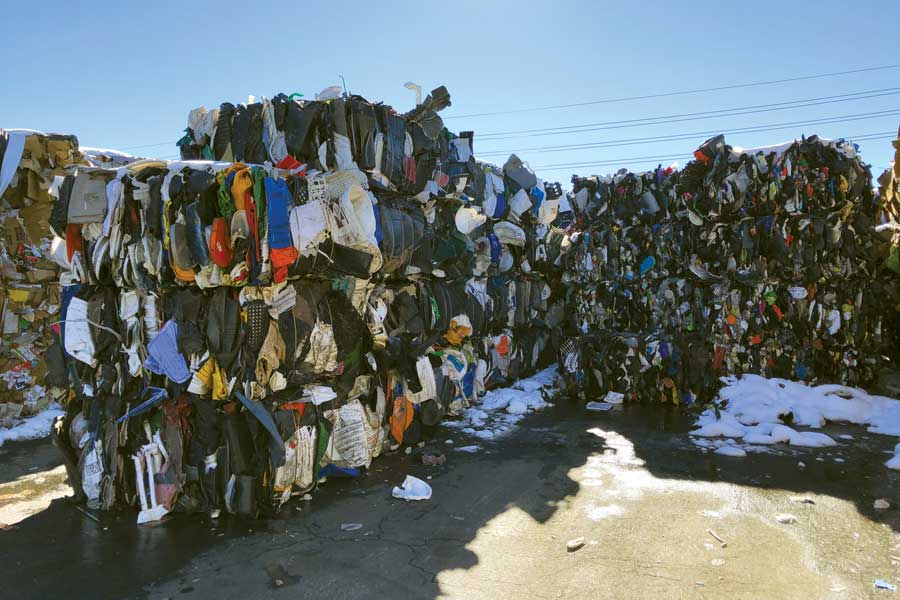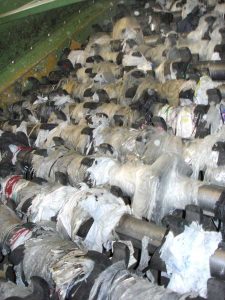Globally, plastic is a pollution nightmare. Locally, Eco-Cycle offers solutions and hope.
10 Jan 2019
The Problem with Plastic
By Tom Brock Plastic is cool. It can bend but be unbreakable. It can be almost weightless, yet tougher than tungsten. You can cover a sandwich, spaceship, house or football field with it—and make it any color you want to dazzle the eye. The one thing you can’t do is get rid of it. Created in numerous forms since the late 1800s, a fully synthetic plastic wasn’t invented until 1907 when phenol was combined with formaldehyde to create Bakelite. Various offshoots of this stuff were used somewhat sparingly for decades, and it wasn’t until the early 1960s that plastic use really caught fire. Plastics were all the rage—you name it and plastic was most likely in it.


Moving Beyond Recycling
BMAG: There are two issues with the bad plastic. You can’t recycle it, and the manufacturing process and materials are more hazardous to health. Harlin: Kate mentioned number six polystyrene. We have known for quite some time that this is a hazardous material. It’s made with benzene and styrene. It’s very hazardous to the workers producing it, and there are also concerns that food-grade containers, when you put a hot beverage or a hot food in that, that those chemicals can leach out. Eco-Cycle is working with Environment Colorado on a statewide ban of food-grade polystyrene containers. So, as an example, if people in Boulder are concerned, they can take action by going to our website and signing our pledge to “ban the foam.” BMAG: Speaking of banning plastics, Colorado law says you can’t ban plastics. True? Harlin: There is a thing called plastic preemption. In the mid-’90s, as part of a bill that dealt with encouraging state agencies to use more recyclable materials, two sentences were inserted that say that municipalities in Colorado may neither require nor prohibit the use of plastics. That’s the plastic preemption. So, technically, local communities cannot ban plastic products in Colorado. The state could, hence the polystyrene ban I was mentioning earlier. That would be a state-level action. Kate: Meanwhile, across the country, we’re seeing a lot of communities banning disposable plastics. While they’re looking at a ban, they’re also looking at how do we create more opportunity for reuse? How can we reward people who reuse their bags? We’re seeing that a lot around the world as well. The EU has now said all plastics must be recyclable or compostable or reusable by 2030. So unfortunately, meanwhile our hands in Boulder are a little more tied, but there’s certainly a growing global consensus that this is a huge problem. BMAG: Do you have any info on the success of Boulder’s plastic bag fee? Kate: The city reported an almost 70 percent decrease in overall bag use once the fee went into place, so people were clearly not taking bags or bringing their own reusable bags, or some stores switched to cardboard boxes, so we definitely saw that that fee had an immediate and lasting impact on reducing bag use. BMAG: What else is new for Eco-Cycle’s plastic recycling? Kate: Guidelines have recently changed. We installed some new equipment at the BCRC, so we were able to expand some of the plastics we are now able to take. We can take five gallon plastic buckets, we can take yogurt tub lids, we can also take the berry, or the clamshell containers, we call them—like the large salad containers. The other question we get a lot from people is about bottle caps. If you have a plastic bottle, the plastic bottle cap should be screwed back on the bottle, and then that gets recycled. Please don’t give us just the cap itself. We’re not able to pull that out. Mixing materials is also a problem. If it’s a glass bottle with a plastic lid, we can’t take those together, but as long as it’s like your soda bottle—plastic bottle, plastic lid—empty it out, screw it back on, and we can recycle that. BMAG: How have market conditions changed what you do with plastics that may or may not be attractive to the marketplace? Kate: That’s a great question. It gets to the point that we’re looking at recycling as the solution to help with plastics, but we’re just responding to all these products that manufacturers are throwing at us. To be honest, of all the plastics ever made, only nine percent have ever been recycled, so we are not able to keep up with demand. We will never be able to recycle all plastics. That should not be the goal. The plastics that you give us in the bin, if they’re what we ask for, they get recycled, 100 percent. We need to be looking at the manufacturers who are making all these products. How are they helping in the recycling process? They need to be buying these products back. We need a place to be able to sell them. BMAG: How does Eco-Cycle encourage a change in how plastics are made and used? Harlin: Eco-Cycle is about building zero-waste communities, and when we talk about zero waste, we tend to focus on downstream solutions to our waste problem, and a downstream solution is recycling. But we really also need to be focusing on upstream—what are we creating in the first place? What are we allowing to be created? What kinds of materials are manufacturers using? We would argue for significantly greater producer responsibility in the U.S. so that when you’re manufacturing your product, you’re not only looking at does it work as intended? Is it attractive? We would like manufacturers to also be looking at can it be reused? How long does it last? Can it be recycled? Can it be composted? Kate: We want to build toward a circular economy. We want materials to be kept in the loop. So we’re also … you know, plastics are a very hot topic right now, which is great, and so, it’s a chance for us to stand up as recyclers and say, “We’re trying to help this problem, but we’re not alone going to solve the problem. Recycling is not the single answer.” There’s a great report from the Ellen MacArthur Foundation that lays out a vision of where we can go, and it says 50 percent of plastics could be recycled. Another 30 percent could be redesigned, maybe eliminated, those are your straws, things that maybe we don’t need, and then 20 percent could maybe be reused. It lays out a good vision of this as a multiple-pronged approach. This is a great time for us to look at all the plastic problems. Plastic production is supposed to quadruple by 2050. Our oceans are filling up with plastic particles. They’re all over our beaches. Is this really the future we want? This is a great time to say, “Time out, let’s look at the big picture, and make macro-level changes to truly fix our plastic problems.” BMAG: To Harlin’s point earlier, plastic doesn’t go anywhere. Do we know how bad it is for our health, or is it too early to tell? Kate: I think it’s a little too early to tell, but there’s a lot of indication that it’s not good. One of the problems is not that we’re ingesting these plastic particles, but what we’re seeing in the ocean is that plastic attracts other chemicals that bond to it, and they’re called persistent pollutants, They’re some of your more dangerous, more toxic chemicals. They’re sort of clinging onto the plastic, and then they’re being introduced into the fish or into our bodies, so it’s not just the plastic particle itself, but all the chemicals that are coming with it. BMAG: So it’s like when a little piece of Styrofoam attracts a bunch of other tiny pieces? Kate: Exactly, we’re watching it move up the food chain in the ocean, and now we’re seeing people ingest it, and we’re still in the early stages of figuring out the research, but we always turn to the precautionary principle, which is basically, an ounce of prevention is worth a pound of cure. If this looks like it’s going to be a problem, let’s start acting before we can be sure. Harlin: And just to add to that, we’re talking a lot about the oceans, and that’s incredibly important, and it’s very visible and prominent right now, but you know, we have these small bits of plastic called microplastics here in Boulder County. You take a shirt that’s made out of polyester and run it through the washer which creates friction pulling plastic microfibers from the clothing. Those plastic fibers eventually end up in the wastewater treatment plant. I just wanted to make the point that we’re here in landlocked Boulder, and yes, we have a crisis with our oceans, but we’re also directly affected by these materials. These microplastics are here as well. It’s everywhere. BMAG: What other issues should we be thinking about? Harlin: Kate mentioned earlier that virtually all plastics are made from oil or natural gas, and the large corporate petrochemical companies, the ExxonMobils of the world, are increasingly getting larger and larger sales and a lot more profit off of what we’re calling unnecessary plastics. The plastic bag was not made because consumers were demanding it. It was made because ExxonMobil’s precursor figured out a way to take natural gas feedstocks and make plastic disposable bags out of them. BMAG: Reports say the new money being invested in new plastics industries is greater than all that has been invested to date. True? Harlin: The Center for International Environmental Law, based in Washington, D.C., has done a series of reports on plastic throughout the entire life cycle. One report examined the corporate leaders and found that they are planning to invest about $164 billion over the next five years or so, to build new or expand existing facilities, some 264 in total. Once that infrastructure is in place, we may have locked in a certain amount of plastic production that we may not even want.
Solutions For The Future
BMAG: You mentioned the circular economy model. How does that pertain to plastics? Kate: We’re seeing a lot of global focus on circular economy, whether it’s around plastics or whether it’s around climate. How do we use our resources more sustainably? How do we, in a circular economy, keep them moving through? Instead of cutting down trees to make new paper, how do we recycle that paper and use it over and over again? We’re seeing a lot of great initiatives come out of Europe. How do we incentivize companies to do this? How do we design products that we’re going to buy this back, and use again in manufacturing? A great example is the EU required car manufacturers to take their cars back for recycling. BMW took their car back and tried to dismantle it, and they were like, “Oh, there’s all these different types of plastics and they’re not labeled!” So they redesigned and they simplified, and there are now three types of plastics. They can dismantle the whole car in three hours because they connected the designer with the end process. We’re seeing a lot of movement in that direction. We’ve seen the U.S. Chamber of Commerce embrace circular economy as the future. I would say we’re seeing bright spots everywhere, which is really fun. We’re seeing a lot of ways that you as a consumer, you as a recycler, can reduce your plastic use, so we did a plastic-free challenge at Eco-Cycle, so you can find that on our website. So you learn about what you can do in your own life, and we also encourage people to look at, what’s that next step? What can you do at your work or your school or your church to replace some of these plastics? Then how can you go farther, and how do you talk to your local city council about a plastic bag fee, or helping ban Styrofoam at the state level. So each one of us has an opportunity to create change in our individual life and then ripple out throughout the community and kind of find out that role, and we’re seeing so much momentum globally around all of this. It’s super exciting.












